Abstract
The lysosomal hydrolase alpha-L-iduronidase (IDUA) is one of the enzymes in the metabolic pathway responsible for the degradation of the glycosaminoglycans heparan sulfate and dermatan sulfate. In humans a deficiency of IDUA leads to the accumulation of glycosaminoglycans, resulting in the lysosomal storage disorder mucopolysaccharidosis type I. A genomic subclone and a cDNA clone encoding human IDUA were used to localize IDUA to chromosome 4p16.3 by in situ hybridization and this was confirmed by Southern blot analysis. This localization is different from that of a previous report mapping IDUA to chromosome 22 and places the gene for IDUA in the same region of chromosome 4 as the Huntington disease gene. Measurement of expressed human IDUA activity in human-mouse hybrid cell lines confirmed that IDUA is on chromosome 4.
Full text
PDF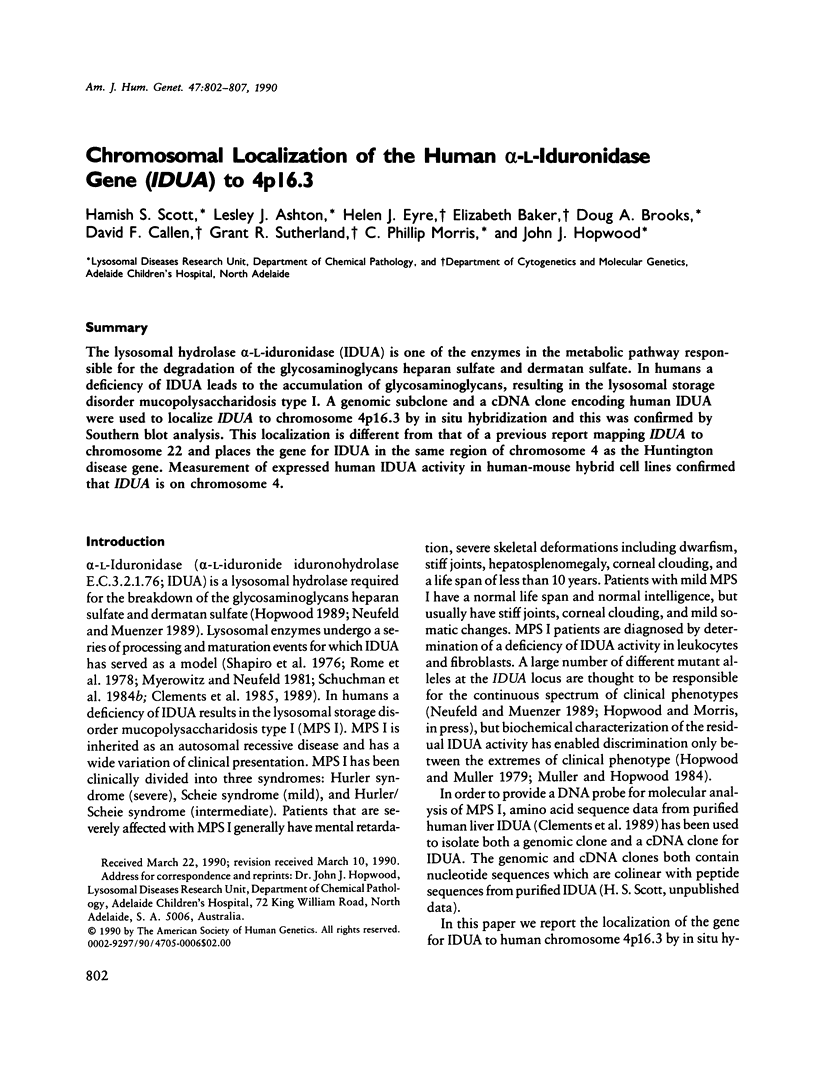
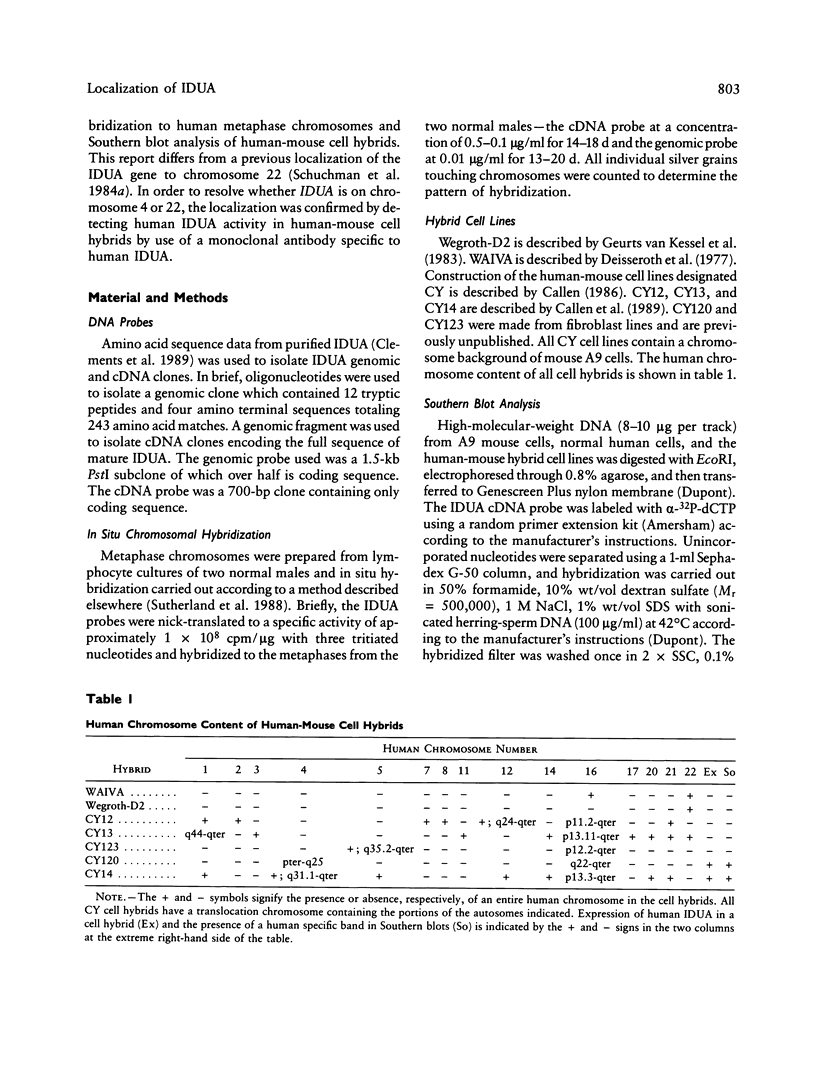
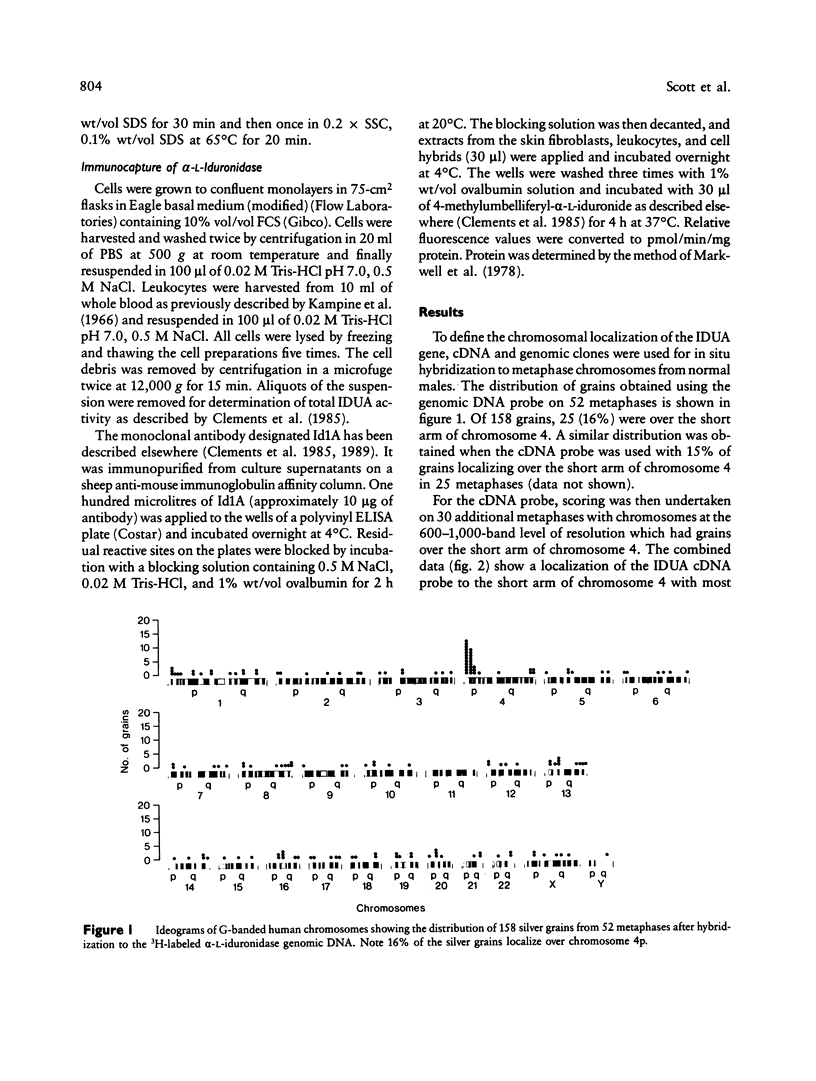
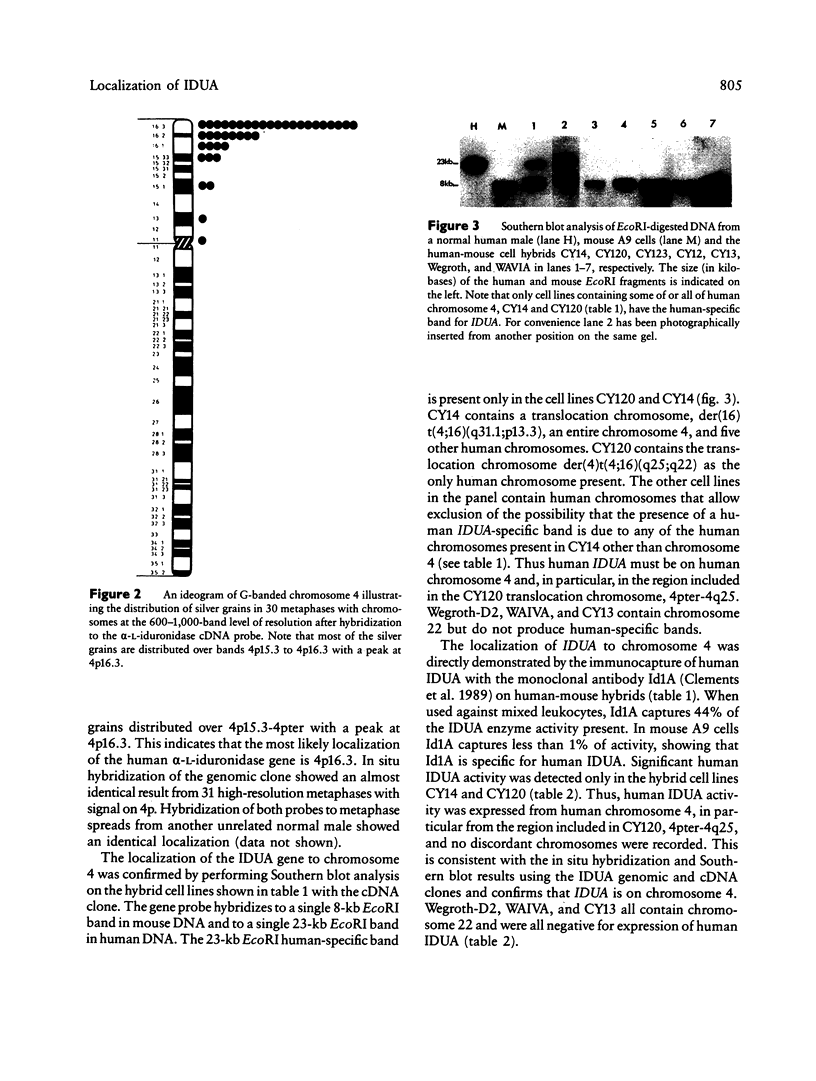
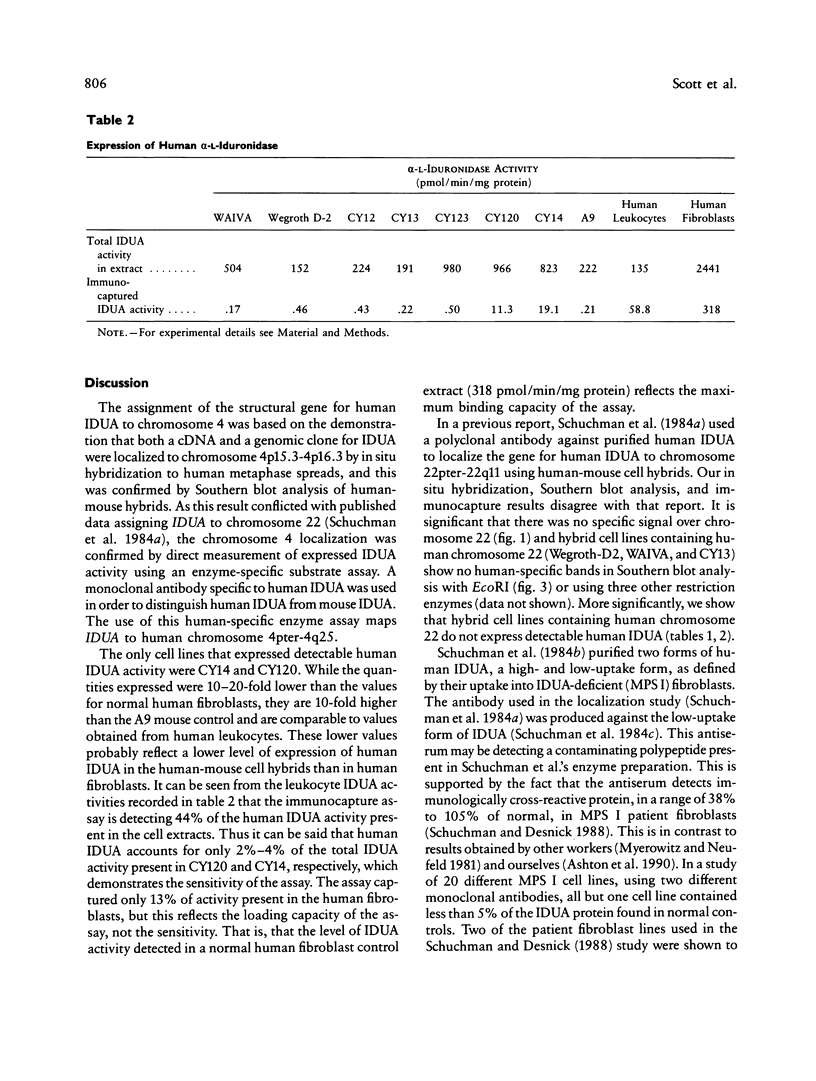
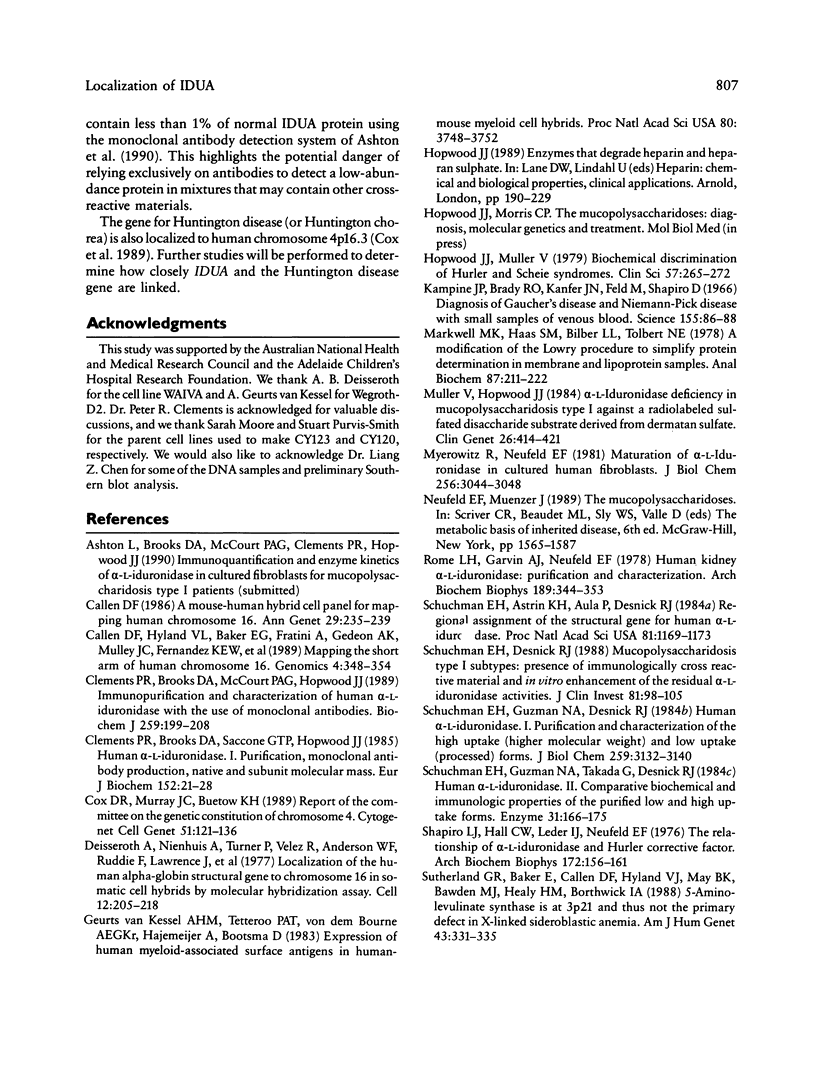
Images in this article
Selected References
These references are in PubMed. This may not be the complete list of references from this article.
- Brown W. E., Seamon K. B. Quantitation and characterization of the trifluoroacetonyl derivative of cysteine: a useful NMR probe. Anal Biochem. 1978 Jun 15;87(1):211–222. doi: 10.1016/0003-2697(78)90587-0. [DOI] [PubMed] [Google Scholar]
- Callen D. F., Hyland V. J., Baker E. G., Fratini A., Gedeon A. K., Mulley J. C., Fernandez K. E., Breuning M. H., Sutherland G. R. Mapping the short arm of human chromosome 16. Genomics. 1989 Apr;4(3):348–354. doi: 10.1016/0888-7543(89)90341-8. [DOI] [PubMed] [Google Scholar]
- Clements P. R., Brooks D. A., McCourt P. A., Hopwood J. J. Immunopurification and characterization of human alpha-L-iduronidase with the use of monoclonal antibodies. Biochem J. 1989 Apr 1;259(1):199–208. doi: 10.1042/bj2590199. [DOI] [PMC free article] [PubMed] [Google Scholar]
- Clements P. R., Brooks D. A., Saccone G. T., Hopwood J. J. Human alpha-L-iduronidase. 1. Purification, monoclonal antibody production, native and subunit molecular mass. Eur J Biochem. 1985 Oct 1;152(1):21–28. doi: 10.1111/j.1432-1033.1985.tb09158.x. [DOI] [PubMed] [Google Scholar]
- Cox D. R., Murray J. C., Buetow K. H. Report of the committee on the genetic constitution of chromosome 4. Cytogenet Cell Genet. 1989;51(1-4):121–136. doi: 10.1159/000132788. [DOI] [PubMed] [Google Scholar]
- Deisseroth A., Nienhuis A., Turner P., Velez R., Anderson W. F., Ruddle F., Lawrence J., Creagan R., Kucherlapati R. Localization of the human alpha-globin structural gene to chromosome 16 in somatic cell hybrids by molecular hybridization assay. Cell. 1977 Sep;12(1):205–218. doi: 10.1016/0092-8674(77)90198-2. [DOI] [PubMed] [Google Scholar]
- Geurts van Kessel A. H., Tetteroo P. A., von dem Borne A. E., Hagemeijer A., Bootsma D. Expression of human myeloid-associated surface antigens in human-mouse myeloid cell hybrids. Proc Natl Acad Sci U S A. 1983 Jun;80(12):3748–3752. doi: 10.1073/pnas.80.12.3748. [DOI] [PMC free article] [PubMed] [Google Scholar]
- Hopwood J. J., Muller V. Biochemical discrimination of Hurler and Scheie syndromes. Clin Sci (Lond) 1979 Sep;57(3):265–272. doi: 10.1042/cs0570265. [DOI] [PubMed] [Google Scholar]
- Kampine J. P., Brady R. O., Kanfer J. N., Feld M., Shapiro D. Diagnosis of gaucher's disease and niemann-pick disease with small samples of venous blood. Science. 1967 Jan 6;155(3758):86–88. doi: 10.1126/science.155.3758.86. [DOI] [PubMed] [Google Scholar]
- Muller V. J., Hopwood J. J. alpha-L-Iduronidase deficiency in mucopolysaccharidosis type I against a radiolabelled sulfated disaccharide substrate derived from dermatan sulfate. Clin Genet. 1984 Nov;26(5):414–421. doi: 10.1111/j.1399-0004.1984.tb01081.x. [DOI] [PubMed] [Google Scholar]
- Myerowitz R., Neufeld E. F. Maturation of alpha-L-iduronidase in cultured human fibroblasts. J Biol Chem. 1981 Mar 25;256(6):3044–3048. [PubMed] [Google Scholar]
- Rome L. H., Garvin A. J., Neufeld E. F. Human kidney alpha-L-iduronidase: purification and characterization. Arch Biochem Biophys. 1978 Aug;189(2):344–353. doi: 10.1016/0003-9861(78)90221-7. [DOI] [PubMed] [Google Scholar]
- Schuchman E. H., Astrin K. H., Aula P., Desnick R. J. Regional assignment of the structural gene for human alpha-L-iduronidase. Proc Natl Acad Sci U S A. 1984 Feb;81(4):1169–1173. doi: 10.1073/pnas.81.4.1169. [DOI] [PMC free article] [PubMed] [Google Scholar]
- Schuchman E. H., Desnick R. J. Mucopolysaccharidosis type I subtypes. Presence of immunologically cross-reactive material and in vitro enhancement of the residual alpha-L-iduronidase activities. J Clin Invest. 1988 Jan;81(1):98–105. doi: 10.1172/JCI113317. [DOI] [PMC free article] [PubMed] [Google Scholar]
- Schuchman E. H., Guzman N. A., Desnick R. J. Human alpha-L-iduronidase. I. Purification and properties of the high uptake (higher molecular weight) and the low uptake (processed) forms. J Biol Chem. 1984 Mar 10;259(5):3132–3140. [PubMed] [Google Scholar]
- Schuchman E. H., Guzman N. A., Takada G., Desnick R. J. Human alpha-L-iduronidase. II. Comparative biochemical and immunologic properties of the purified low and high uptake forms. Enzyme. 1984;31(3):166–175. [PubMed] [Google Scholar]
- Shapiro L. J., Hall C. W., Leder I. G., Neufeld E. F. The relationship of alpha-L-iduronidase and Hurler corrective factor. Arch Biochem Biophys. 1976 Jan;172(1):156–161. doi: 10.1016/0003-9861(76)90061-8. [DOI] [PubMed] [Google Scholar]
- Sutherland G. R., Baker E., Callen D. F., Hyland V. J., May B. K., Bawden M. J., Healy H. M., Borthwick I. A. 5-Aminolevulinate synthase is at 3p21 and thus not the primary defect in X-linked sideroblastic anemia. Am J Hum Genet. 1988 Sep;43(3):331–335. [PMC free article] [PubMed] [Google Scholar]



